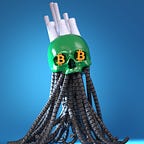Solanium: Proof of Stake Consensus
Proof-of-Stake is a consensus process in which the next block’s creator is chosen dependent on the network’s participants’ coin holdings.
Description
This instance of Proof of Stake is intended for speedy validation of the existing Proof of History chain, voting and selection of the next Proof of History generator, and retribution of any misbehaving validators.
This method relies on information reaching all active nodes within a predetermined timeframe.
Terminology
Bonds
In Proof of Work, bonds are the same as capital expenses. In a Proof of Work blockchain, a miner purchases hardware and power and submits it to a specific branch. A bond is a form of collateral that the validator pledges to when verifying transactions.
Slashing
In Proof of Stake systems, this is a suggested solution to the “nothing at stake” dilemma. The validator’s bond can be destroyed when proof of voting for a different branch is released. This is a financial incentive to keep validators from accepting numerous branches.
Super Majority
Two-thirds of validators, graded by their bonds, form a supermajority. A supermajority vote signifies that the network has attained consensus, and for this node to be erroneous, at least one-third of the network would have to vote maliciously.
An attack would cost at least one-third of the coin’s market capitalization.
Bonding
A bonding transaction transfers a certain quantity of coins to a bonding account in the user’s name. Bonding account coins cannot be used and must be kept in the account till the user retrieves them.
Only timed-out stale coins can be removed by the user. Bonds are effective if the sequence has been confirmed by a supermajority of the present stakeholders.
Voting
The Proof of History generator is expected to be able to generate a state signature within a predetermined time frame. Every linked identity must verify that signature by posting its state-signed signature.
Without a no, the vote is a clear yes. This branch would be considered legitimate if a super majority of connected identities voted within a delay.
Unbonding
If N votes are missing, the coins are considered obsolete and no more available for voting. To unbond them, the user can perform an unbonding transaction.
N is a vital number depending on the number of obsolete votes against active votes. As the number of obsolete votes grows, so does N. This enables the bigger branch to heal quicker than the lesser branch in the case of a major network breakdown.
Election
When a PoH generator fails, a new one is chosen. The new PoH generator is chosen by the validator with the most votes cast, or by the validator with the greatest public key address in the event of a tie. On the new sequence, you’ll need a supermajority of approvals.
In conclusion, during a Primary breakdown, if a Secondary exists, it will be declared the next leader. If an error is discovered or on a specified timetable, the platform is built so that the Secondary becomes Primary and lower rank generators are elevated.
Like, comment, and remember to subscribe to receive more information on Solanium, and other crypto-related topics.
About Solanium
The Solana blockchain uses Solanium as its main platform. Engage in public token sales, stake your tokens, trade on our DEX, contribute in our governance, and become a part of our active and expanding community.
Solanium’s objective is to make Solana accessible to everyone, with an emphasis on UI/UX and solid collaborations and synergies throughout the Solana environment.
Solanium Socials:
Twitter: https://twitter.com/solanium_io
Telegram Lobby: https://t.me/solanium_io_chat
Telegram Announcement Channel: https://t.me/solanium_io
